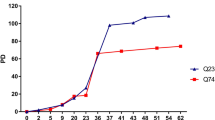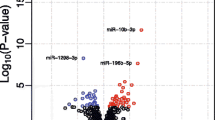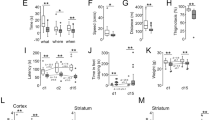Abstract
Huntington’s disease (HD) is a neurodegenerative disorder caused by a trinucleotide repeat expansion in the huntingtin gene. Transcriptomic dysregulations are well-documented in HD and alterations in small non-coding RNAs (sncRNAs), particularly microRNAs (miRNAs), could underpin that phenomenon. Additionally, environmental enrichment (EE), which is used to model a stimulating lifestyle in pre-clinical research, has been shown to ameliorate HD-related symptoms. However, the mechanisms mediating the therapeutic effects of EE remain largely unknown. This study assessed the effect of EE on sncRNA expression in the striatum of female R6/1 transgenic HD mice at 12 weeks (prior to over motor deficits) and 20 weeks (fully symptomatic) of age. When comparing wild-type and R6/1 mice in the standard housing condition, we found 6 and 64 miRNAs that were differentially expressed at 12 and 20 weeks of age, respectively. The 6 miRNAs (miR-132, miR-212, miR-222, miR-1a, miR-467a, and miR-669c) were commonly dysregulated at both time points. Additionally, genotype had minor effects on the levels of other sncRNAs, in particular, 1 piRNA was dysregulated at 12 weeks of age, and at 20 weeks of age 11 piRNAs, 1 tRNA- and 2 snoRNA-derived fragments were altered in HD mice. No difference in the abundance of other sncRNA subtypes, including rRNA- and snRNA- derived fragments, were observed. While EE improved locomotor symptoms in HD, we found no effect of the housing condition on any of the sncRNA populations examined. Our findings show that HD mainly affects miRNAs and has a minor effect on other sncRNA populations. Furthermore, the therapeutic effects of EE are not associated with the rescue of these dysregulated sncRNAs and may therefore exert these experience-dependent effects via other molecular mechanisms.



Similar content being viewed by others
Code Availability
Not applicable.
Data Availability
The raw dataset supporting the conclusions of this article is available upon request.
References
Vonsattel JPG, DiFiglia M (1998) Huntington disease. J Neuropathol Exp Neurol 57:369–384
Hodges A, Strand AD, Aragaki AK, Kuhn A, Sengstag T, Hughes G, Elliston LA, Hartog C et al (2006) Regional and cellular gene expression changes in human Huntington’s disease brain. Hum Mol Genet 15:965–977
Luthi-Carter R, Hanson SA, Strand AD, Bergstrom DA, Chun W, Peters NL, Woods AM, Chan EY et al (2002) Dysregulation of gene expression in the R6/2 model of polyglutamine disease: parallel changes in muscle and brain. Hum Mol Genet 11:1911–1926
Desplats PA, Kass KE, Gilmartin T, Stanwood GD, Woodward EL, Head SR, Sutcliffe JG, Thomas EA (2006) Selective deficits in the expression of striatal-enriched mRNAs in Huntington’s disease. J Neurochem 96:743–757
O’Carroll D, Schaefer A (2013) General principals of miRNA biogenesis and regulation in the brain. Neuropsychopharmacology 38:39–54
Kuss AW, Chen W (2008) MicroRNAs in brain function and disease. Curr Neurol Neurosci Rep 8:190–197
Packer AN, Xing Y, Harper SQ, Jones L, Davidson BL (2008) The bifunctional microRNA miR-9/miR-9* regulates REST and CoREST and is downregulated in Huntington’s disease. J Neurosci 28:14341–14346
Johnson R, Zuccato C, Belyaev ND, Guest DJ, Cattaneo E, Buckley NJ (2008) A microRNA-based gene dysregulation pathway in Huntington’s disease. Neurobiol Dis 29:438–445
Lee S-T, Chu K, Im W-S, Yoon HJ, Im JY, Park JE, Park KH, Jung KH et al (2011) Altered microRNA regulation in Huntington’s disease models. Exp Neurol 227:172–179
Hoss AG, Kartha VK, Dong X, Latourelle JC, Dumitriu A, Hadzi TC, MacDonald ME, Gusella JF, Akbarian S, Chen J-F (2014) MicroRNAs located in the Hox gene clusters are implicated in huntington’s disease pathogenesis. PLoS Genet 10
Pircs K, Petri R, Madsen S, Brattås PL, Vuono R, Ottosson DR, St-Amour I, Hersbach BA et al (2018) Huntingtin aggregation impairs autophagy, leading to argonaute-2 accumulation and global microRNA dysregulation. Cell Rep 24:1397–1406
Ender C, Krek A, Friedländer MR, Beitzinger M, Weinmann L, Chen W, Pfeffer S, Rajewsky N et al (2008) A human snoRNA with microRNA-like functions. Mol Cell 32:519–528
Li Z, Ender C, Meister G, Moore PS, Chang Y, John B (2012) Extensive terminal and asymmetric processing of small RNAs from rRNAs, snoRNAs, snRNAs, and tRNAs. Nucleic Acids Res 40:6787–6799
Zuo L, Wang Z, Tan Y, Chen X, Luo X (2016) piRNAs and their functions in the brain. Int J Hum Genet 16:53–60
Shen Y, Yu X, Zhu L, Li T, Yan Z, Guo J (2018) Transfer RNA-derived fragments and tRNA halves: biogenesis, biological functions and their roles in diseases. J Mol Med 96:1167–1176
Qiu W, Guo X, Lin X, Yang Q, Zhang W, Zhang Y, Zuo L, Zhu Y et al (2017) Transcriptome-wide piRNA profiling in human brains of Alzheimer’s disease. Neurobiol Aging 57:170–177
Roy J, Sarkar A, Parida S, Ghosh Z, Mallick B (2017) Small RNA sequencing revealed dysregulated piRNAs in Alzheimer’s disease and their probable role in pathogenesis. Mol BioSyst 13:565–576
Magee R, Londin E, Rigoutsos I (2019) TRNA-derived fragments as sex-dependent circulating candidate biomarkers for Parkinson’s disease. Parkinsonism Relat Disord 65:203–209
Zajac M, Pang TY, Wong N, Weinrich B, Leang L, Craig JM, Saffery R, Hannan AJ (2010) Wheel running and environmental enrichment differentially modify exon-specific BDNF expression in the hippocampus of wild-type and pre-motor symptomatic male and female Huntington’s disease mice. Hippocampus 20:621–636
Du X, Leang L, Mustafa T, Renoir T, Pang TY, Hannan AJ (2012) Environmental enrichment rescues female-specific hyperactivity of the hypothalamic-pituitary-adrenal axis in a model of Huntington’s disease. Transl Psychiatry 2:e133
Renoir T, Pang TYC, Mo C, Chan G, Chevarin C, Lanfumey L, Hannan AJ (2013) Differential effects of early environmental enrichment on emotionality related behaviours in Huntington’s disease transgenic mice. J Physiol Lond 591:41–55
Pang TY, Du X, Zajac MS, Howard ML, Hannan AJ (2009) Altered serotonin receptor expression is associated with depression-related behavior in the R6/1 transgenic mouse model of Huntington’s disease. Hum Mol Genet 18:753–766
Mazarakis NK, Mo C, Renoir T, Van Dellen A, Deacon R, Blakemore C, Hannan AJ (2014) ‘Super-enrichment’reveals dose-dependent therapeutic effects of environmental stimulation in a transgenic mouse model of Huntington’s disease. J Huntingtons Dis 3:299–309
Guyenet SJ, Furrer SA, Damian VM, Baughan TD, La Spada AR, Garden GA (2010) A simple composite phenotype scoring system for evaluating mouse models of cerebellar ataxia. J Vis Exp e1787
Martin M (2011) Cutadapt removes adapter sequences from high-throughput sequencing reads. EMBnet.journal 17:10–12
Andrews S (2010) FastQC: a quality control tool for high throughput sequence data
Li H, Durbin R (2009) Fast and accurate short read alignment with Burrows–Wheeler transform. Bioinformatics 25:1754–1760
Liao Y, Smyth GK, Shi W (2013) The Subread aligner: fast, accurate and scalable read mapping by seed-and-vote. Nucleic Acids Res 41:e108–e108
Griffiths-Jones S, Saini HK, Van Dongen S, Enright AJ (2007) miRBase: tools for microRNA genomics. Nucleic Acids Res 36:D154–D158
Chan PP, Lowe TM (2009) GtRNAdb: a database of transfer RNA genes detected in genomic sequence. Nucleic Acids Res 37:D93–D97
Wang J, Zhang P, Lu Y, Li Y, Zheng Y, Kan Y, Chen R, He S (2019) piRBase: a comprehensive database of piRNA sequences. Nucleic Acids Res 47:D175–D180
Cunningham F, Achuthan P, Akanni W, Allen J, Amode MR, Armean IM, Bennett R, Bhai J et al (2019) Ensembl 2019. Nucleic Acids Res 47:D745–D751
Love MI, Huber W, Anders S (2014) Moderated estimation of fold change and dispersion for RNA-seq data with DESeq2. Genome Biol 15:550
Dweep H, Sticht C, Pandey P, Gretz N (2011) miRWalk – database: prediction of possible miRNA binding sites by “walking” the genes of three genomes. J Biomed Inform 44:839–847
Chen J, Bardes EE, Aronow BJ, Jegga AG (2009) ToppGene Suite for gene list enrichment analysis and candidate gene prioritization. Nucleic Acids Res 37:W305–W311
Martí E, Pantano L, Bañez-Coronel M, Llorens F, Miñones-Moyano E, Porta S, Sumoy L, Ferrer I et al (2010) A myriad of miRNA variants in control and Huntington’s disease brain regions detected by massively parallel sequencing. Nucleic Acids Res 38:7219–7235
Daugaard I, Hansen TB (2017) Biogenesis and function of ago-associated RNAs. Trends Genet 33:208–219
Lambert M, Benmoussa A, Provost P (2019) Small non-coding RNAs derived from eukaryotic ribosomal RNA. Noncoding RNA. https://doi.org/10.3390/ncrna5010016
Fukuoka M, Takahashi M, Fujita H, Chiyo T, Popiel HA, Watanabe S, Furuya H, Murata M et al (2018) Supplemental treatment for Huntington’s disease with miR-132 that is deficient in Huntington’s disease brain. Mol Ther–Nucleic Acids 11:79–90
Soldati C, Bithell A, Johnston C, Wong K-Y, Stanton LW, Buckley NJ (2013) Dysregulation of REST-regulated coding and non-coding RNAs in a cellular model of Huntington’s disease. J Neurochem 124:418–430
Zuccato C, Tartari M, Crotti A, Goffredo D, Valenza M, Conti L, Cataudella T, Leavitt BR et al (2003) Huntingtin interacts with REST/NRSF to modulate the transcription of NRSE-controlled neuronal genes. Nat Genet 35:76–83
Choi Y-S, Lee B, Cho H-Y, Reyes IB, Pu X-A, Saido TC, Hoyt KR, Obrietan K (2009) CREB is a key regulator of striatal vulnerability in chemical and genetic models of Huntington’s disease. Neurobiol Dis 36:259–268
Wanet A, Tacheny A, Arnould T, Renard P (2012) miR-212/132 expression and functions: within and beyond the neuronal compartment. Nucleic Acids Res 40:4742–4753
Druz A, Chu C, Majors B, Santuary R, Betenbaugh M, Shiloach J (2011) A novel microRNA mmu-miR-466h affects apoptosis regulation in mammalian cells. Biotechnol Bioeng 108:1651–1661
Druz A, Betenbaugh M, Shiloach J (2012) Glucose depletion activates mmu-miR-466h-5p expression through oxidative stress and inhibition of histone deacetylation. Nucleic Acids Res 40:7291–7302
Powers WJ, Videen TO, Markham J, McGee-Minnich L, Antenor-Dorsey JV, Hershey T, Perlmutter JS (2007) Selective defect of in vivo glycolysis in early Huntington’s disease striatum. Proc Natl Acad Sci 104:2945–2949
Hervé D (2011) Identification of a specific assembly of the G protein golf as a critical and regulated module of dopamine and adenosine-activated cAMP pathways in the striatum. Front Neuroanat. https://doi.org/10.3389/fnana.2011.00048
Agus F, Crespo D, Myers RH, Labadorf A (2019) The caudate nucleus undergoes dramatic and unique transcriptional changes in human prodromal Huntington’s disease brain. BMC Med Genet 12:137
Rujano MA, Kampinga HH, Salomons FA (2007) Modulation of polyglutamine inclusion formation by the Hsp70 chaperone machine. Exp Cell Res 313:3568–3578
Faust O, Abayev-Avraham M, Wentink AS, Maurer M, Nillegoda NB, London N, Bukau B, Rosenzweig R (2020) HSP40 proteins use class-specific regulation to drive HSP70 functional diversity. Nature 587:489–494
Popiel HA, Takeuchi T, Fujita H, Yamamoto K, Ito C, Yamane H, Muramatsu S, Toda T et al (2012) Hsp40 gene therapy exerts therapeutic effects on polyglutamine disease mice via a non-cell autonomous mechanism. PLoS One 7:e51069
Kuhn A, Goldstein DR, Hodges A, Strand AD, Sengstag T, Kooperberg C, Becanovic K, Pouladi MA et al (2007) Mutant huntingtin’s effects on striatal gene expression in mice recapitulate changes observed in human Huntington’s disease brain and do not differ with mutant huntingtin length or wild-type huntingtin dosage. Hum Mol Genet 16:1845–1861
Mielcarek M, Mazur-Michałek I, Marcinkowski J, Wieleba M, Klimberg A, Zielonka D (2019) Expression levels of MEF transcription factors in skeletal muscles of Huntington’s disease mouse model. 54:64–67
Vidal-Sancho L, Fernández-García S, Solés-Tarrés I, Alberch J, Xifró X (2020) Decreased myocyte enhancer factor 2 levels in the hippocampus of Huntington’s disease mice are related to cognitive dysfunction. Mol Neurobiol 57:4549–4562
Krzysztoń-Russjan J, Zielonka D, Jackiewicz J, Kuśmirek S, Bubko I, Klimberg A, Marcinkowski JT, Anuszewska EL (2013) A study of molecular changes relating to energy metabolism and cellular stress in people with Huntington’s disease: looking for biomarkers. J Bioenerg Biomembr 45:71–85
Mielcarek M, Landles C, Weiss A, Bradaia A, Seredenina T, Inuabasi L, Osborne GF, Wadel K et al (2013) HDAC4 reduction: a novel therapeutic strategy to target cytoplasmic huntingtin and ameliorate neurodegeneration. PLoS Biol 11:e1001717
Sharma S, Taliyan R (2015) Transcriptional dysregulation in Huntington’s disease: the role of histone deacetylases. Pharmacol Res 100:157–169
Mielcarek M, Benn CL, Franklin SA, Smith DL, Woodman B, Marks PA, Bates GP (2011) SAHA decreases HDAC 2 and 4 levels in vivo and improves molecular phenotypes in the R6/2 mouse model of Huntington’s disease. PLoS One 6:e27746
Schulze M, Sommer A, Plötz S, Farrell M, Winner B, Grosch J, Winkler J, Riemenschneider MJ (2018) Sporadic Parkinson’s disease derived neuronal cells show disease-specific mRNA and small RNA signatures with abundant deregulation of piRNAs. Acta Neuropathol Commun 6:58
Rajasethupathy P, Antonov I, Sheridan R, Frey S, Sander C, Tuschl T, Kandel ER (2012) A role for neuronal piRNAs in the epigenetic control of memory-related synaptic plasticity. Cell 149:693–707
Kim VN, Han J, Siomi MC (2009) Biogenesis of small RNAs in animals. Nat Rev Mol Cell Biol 10:126–139
Wood NI, Carta V, Milde S, Skillings EA, McAllister CJ, Ang YLM, Duguid A, Wijesuriya N et al (2010) Responses to Environmental enrichment differ with sex and genotype in a transgenic mouse model of Huntington’s disease. PLoS One 5:e9077
Benn CL, Luthi-Carter R, Kuhn A, Sadri-Vakili G, Blankson KL, Dalai SC, Goldstein DR, Spires TL et al (2010) Environmental enrichment reduces neuronal intranuclear inclusion load but has no effect on messenger RNA expression in a mouse model of Huntington disease. J Neuropathol Exp Neurol 69:817–827
Vonsattel J-P, Myers RH, Stevens TJ, Ferrante RJ, Bird ED, Richardson EP (1985) Neuropathological classification of Huntington’s disease. J Neuropathol Exp Neurol 44:559–577
Rattray I, Smith EJ, Crum WR, Walker TA, Gale R, Bates GP, Modo M (2013) Correlations of behavioral deficits with brain pathology assessed through longitudinal MRI and histopathology in the R6/1 mouse model of Huntington’s disease. PLoS One 8:e84726
Naver B, Stub C, Møller M, Fenger K, Hansen AK, Hasholt L, Sørensen SA (2003) Molecular and behavioral analysis of the r6/1 huntington′s disease transgenic mouse. Neuroscience 122:1049–1057
Hansson O, Petersen A, Leist M, Nicotera P, Castilho RF, Brundin P (1999) Transgenic mice expressing a Huntington’s disease mutation are resistant to quinolinic acid-induced striatal excitotoxicity. Proc Natl Acad Sci 96:8727–8732
Funding
This work was supported by a National Health and Medical Research (NHMRC) Project Grant to TR and AJH. TR is a NHMRC Boosting Dementia Research Leadership Fellow. AJH is a NHMRC Principal Research Fellow. The Florey Institute of Neuroscience and Mental Health acknowledges the support from the Victorian Government’s Operational Infrastructure Support Grant.
Author information
Authors and Affiliations
Contributions
Celine Dubois, Anthony Hannan, and Thibault Renoir are responsible for the conceptualization. Celine Dubois, Harvey Tran, and Shanshan Li are responsible for the conceptualization methodology. Celine Dubois and Geraldine Kong did the formal analysis and investigation and the writing of original draft preparation. Terence Y. Pang, Anthony Hannan, and Thibault Renoir are involved in the writing of the review and editing, acquired funding, and did the supervision.
Corresponding authors
Ethics declarations
Ethics Approval
All experiments performed in the studies were approved by the Animal Ethics Committee of the Florey Institute of Neuroscience and Mental Health, Melbourne, Australia.
Consent to Participate
Not applicable.
Consent for Publication
All authors consent to publication.
Conflict of Interest
All authors declare no conflicts of interest.
Additional information
Publisher’s Note
Springer Nature remains neutral with regard to jurisdictional claims in published maps and institutional affiliations.
Celine Dubois and Geraldine Kong are joint first authors.
Anthony J. Hannan and Thibault Renoir are joint last authors.
Supplementary Information
ESM 1
(DOCX 713 kb)
Supplementary Table 1:
Differentially expressed sncRNAs in the striatum of HD mice at 12 and 20 weeks of age when compared to their WT littermates, as well as the validated downstream gene targets of the dysregulated miRNAs (XLSX 28 kb)
Rights and permissions
About this article
Cite this article
Dubois, C., Kong, G., Tran, H. et al. Small Non-coding RNAs Are Dysregulated in Huntington’s Disease Transgenic Mice Independently of the Therapeutic Effects of an Environmental Intervention. Mol Neurobiol 58, 3308–3318 (2021). https://doi.org/10.1007/s12035-021-02342-9
Received:
Accepted:
Published:
Issue Date:
DOI: https://doi.org/10.1007/s12035-021-02342-9




